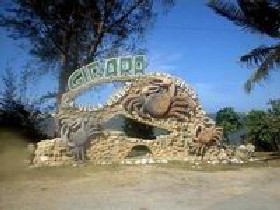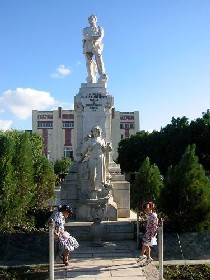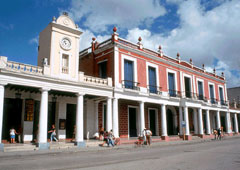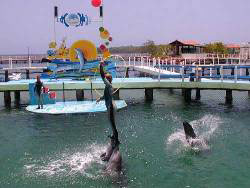|
SEBORUCO HEADLAND (FARALLÓN DE SEBORUCO), MAYARÍ
This National Monument is located next to the city of Mayarí, in the north-eastern province of Holguín where archaeological evidence has been found of aboriginal dwellings of an ancient nomad community.
The findings include cave drawings, ilex knives, food remains as well as human bones and bones of extinct mammals. The dating of the human bones using C14 evidenced that they were over 5 000 years old and that these men were not Arahuacos, but came from Northern America, probably during the glaciations of Wisconsin, migrating from Florida to the Bahamas, some few kilometres north of Cuba during that period. The Arahuacos that came from northern Venezuela arrived later.
For more information:
www.cuba-culturaltours.com
,
www.cuba-holguin.com
,
www.aboutcuba.com
|
|
|
BANES
This cosy town also known as the archaeological capital of Cuba, treasures in its territory a historically valued site named Chorro de Maíta, where the largest aboriginal cemetery of the Antilles is located (it is an archaeological site and museum) as well as the Taina village (AldeaTaína).
To visit the Cultural Recreational Park (Parque Recreativo Cultural) is to live again a history of over 500 years. There is an exhibit showing 56 of the 108 skeletons that were found, among them the single scull of a European, presumably Spanish, that lived with the aborigines as well as that of a young woman adorned with golden attributes, pearls and semiprecious stones, so it is thought that she had an important position within the tribe.
Right across is the Taina Village (Aldea Taína), similar to those built by the people who dwelled in Cuba before the arrival of the Spanish, and that was conceived by a group of artists from Holguin, designers and specialists in this culture.
For more information:
www.cuba-guardalavaca.com
,
www.cuba-holguin.com
,
www.cuba-playapesquero.com
|
|
|
GIBARA
 It is a place where ancestral ruins can be viewed, such as the Cuarterón and the Batería de Fernando VI as well as colonial architecture incredibly well preserved.
The White Villa (Villa Blanca) named this way by some, shows a unique contrast between the sea and the colonial settlement. It is considered the second walled city in Cuba.
Other geographical attractions are the so-called Chair of Gibara (Silla de Gibara), named thus due to its similarity with a saddle. This gift of nature attracted Christopher Columbus’ attention and the Mezquite with which the sailor found similarity with the “Peña de los Enamorados” of Andalucía.
It is a place where ancestral ruins can be viewed, such as the Cuarterón and the Batería de Fernando VI as well as colonial architecture incredibly well preserved.
The White Villa (Villa Blanca) named this way by some, shows a unique contrast between the sea and the colonial settlement. It is considered the second walled city in Cuba.
Other geographical attractions are the so-called Chair of Gibara (Silla de Gibara), named thus due to its similarity with a saddle. This gift of nature attracted Christopher Columbus’ attention and the Mezquite with which the sailor found similarity with the “Peña de los Enamorados” of Andalucía.
For more information:
www.cuba-guardalavaca.com
,
www.cuba-holguin.com
,
www.cuba-playapesquero.com
|
|
|
HOLGUÍN
 It is the capital of the province of the same name, where Christopher Columbus, when he landed on Cuban soil, specifically in the area of Bariay, said, “This is the most beautiful land that human eyes have seen”.
It has been hailed by many the city of the parks, as well as being identified by a high hill that marks what the geographical north is, and on the very peak there is a huge wooden cross. This hill is known as the Hill of the Cross (La Loma de la Cruz). Precisely in this place loaded with beautiful traditions, is where its inhabitants celebrate the May Pilgrimages (Romerías de Mayo), a the popular festivity of the Iberian- American culture.
It is the capital of the province of the same name, where Christopher Columbus, when he landed on Cuban soil, specifically in the area of Bariay, said, “This is the most beautiful land that human eyes have seen”.
It has been hailed by many the city of the parks, as well as being identified by a high hill that marks what the geographical north is, and on the very peak there is a huge wooden cross. This hill is known as the Hill of the Cross (La Loma de la Cruz). Precisely in this place loaded with beautiful traditions, is where its inhabitants celebrate the May Pilgrimages (Romerías de Mayo), a the popular festivity of the Iberian- American culture.
For more information:
www.cuba-guardalavaca.com
,
www.cuba-holguin.com
,
www.cuba-playapesquero.com
|
|
|
La Periquera
 This ancient mansion is found along the Frexes street of Holguin, across from the Calixto García Park, in the very heart of the city and it houses this north western province’s museum. It is a building that treasures a wealth of history, and there is a beautiful popular legend that says that this building had a tunnel that tunnelled under the plaza and ended at the Cross Hill (Loma de la Cruz), where there was a fortress.
During the Ten Year War (Guerra de los Diez Años) (1868-78) the fortress had a lookout that warned of the impending attack of the insurrectionists, in which case the tunnel would fill with water.
With the passing of time, in the upper stories of the building, the headquarters of the Government House (Casa de Gobierno) were established, and afterwards it became the seat of different historical events in the well-known City of the Parks.
This ancient mansion is found along the Frexes street of Holguin, across from the Calixto García Park, in the very heart of the city and it houses this north western province’s museum. It is a building that treasures a wealth of history, and there is a beautiful popular legend that says that this building had a tunnel that tunnelled under the plaza and ended at the Cross Hill (Loma de la Cruz), where there was a fortress.
During the Ten Year War (Guerra de los Diez Años) (1868-78) the fortress had a lookout that warned of the impending attack of the insurrectionists, in which case the tunnel would fill with water.
With the passing of time, in the upper stories of the building, the headquarters of the Government House (Casa de Gobierno) were established, and afterwards it became the seat of different historical events in the well-known City of the Parks.
For more information:
www.cuba-history.com
,
www.cuba-holguin.com
|
|
|
NARANJO BAY. (HOLGUÍN)
 Its natural environment is a strong tourist attraction because of the infinite beauty created by nature, it is located along the road that leads to the exquisite beach of Guardalavaca. The so called natural park of Naranjo Bay (Bahía de Naranjo) is made up of five small isles and the largest -Cayo Jutía- is developing a mini- zoo of Cuban fauna.
Cristóbal Colón Park includes over 5 500 hectares of natural forests, a mosaic of native species, both flora and fauna. There is also a project for preserving valuable sites such as the rock of Naranjo Bay, a beautiful rocky outcropping of 16 hectares, declared an area protected from hotel developments in order to preserve the coastal ecosystem.
Its natural environment is a strong tourist attraction because of the infinite beauty created by nature, it is located along the road that leads to the exquisite beach of Guardalavaca. The so called natural park of Naranjo Bay (Bahía de Naranjo) is made up of five small isles and the largest -Cayo Jutía- is developing a mini- zoo of Cuban fauna.
Cristóbal Colón Park includes over 5 500 hectares of natural forests, a mosaic of native species, both flora and fauna. There is also a project for preserving valuable sites such as the rock of Naranjo Bay, a beautiful rocky outcropping of 16 hectares, declared an area protected from hotel developments in order to preserve the coastal ecosystem.
For more information:
www.cuba-guardalavaca.com
,
www.cuba-holguin.com
|
|